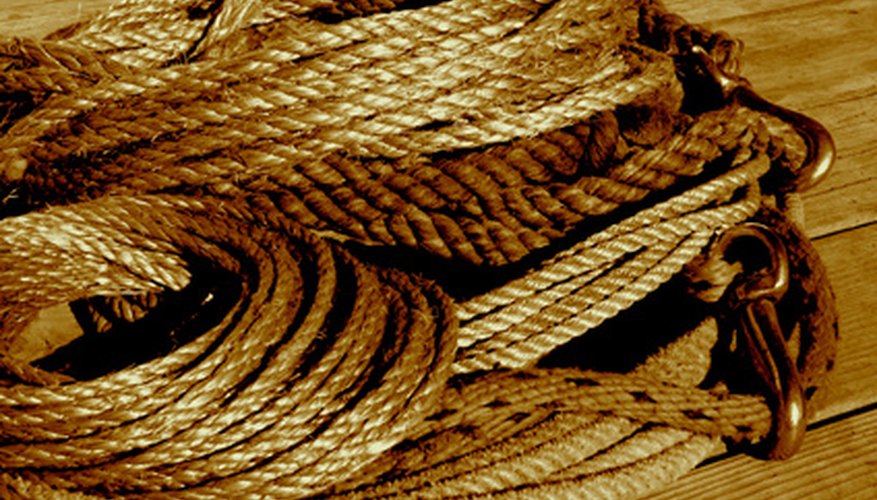Hemp fibre, derived from the Cannabis sativa plant, is a durable material that is stronger and softer than cotton, lasts twice as long and will not mildew, according to hempbasics.com. Using hemp fibres, you can create a rope that is reasonably soft with high enough friction to hold a knot securely. Like most natural fibre ropes, a hemp rope will be fairly rough when untreated, but after a thorough treatment process, will become softer and remain just as durable for a myriad of uses.
- Hemp fibre, derived from the Cannabis sativa plant, is a durable material that is stronger and softer than cotton, lasts twice as long and will not mildew, according to hempbasics.com.
- Using hemp fibres, you can create a rope that is reasonably soft with high enough friction to hold a knot securely.
Coil your hemp rope loosely, and place it in a large metal pan. Fill the bucket with warm water, enough to cover the rope completely. Pre-soaking will speed the treatment process and remove odours from the rope. You may notice that as the water soaks into the rope, it may become twisted and stick out from the water, so prod it with a wooden spoon to ensure that all fibres become saturated.
Remove the rope from the water, and wash it in a standard washing machine on a delicate cycle with a minimal amount of detergent---about half the amount you would use in a standard load.
Remove the cleaned rope from the washing machine, place it in a large metal pan and fill the pan with warm water again. Cover the pan, and bring the rope and the water to a rolling boil. Once the water boils, reduce heat and let simmer for three hours. Allow the rope to completely cool before handling, usually 12 hours or so.
Drain the water and remove the rope from the pan. Place the rope in a tumble dryer on medium heat for one or two cycles, or until the rope is completely dry If the rope seems stiff, it isn't completely dry. You may have to clean the filter midway through the first or second drying cycle, as ropes tend to produce a large amount of lint. If you do not have a dryer, simply hang the rope over a clothesline and allow it to air dry completely.
- Remove the rope from the water, and wash it in a standard washing machine on a delicate cycle with a minimal amount of detergent---about half the amount you would use in a standard load.
- Place the rope in a tumble dryer on medium heat for one or two cycles, or until the rope is completely dry If the rope seems stiff, it isn't completely dry.
After the rope is completely dry, pull it repeatedly over a metal bar or pole to stretch it back out again. This will also serve to soften the outside of the rope and break up the fibres inside.
If small or straw-like pieces of fibre stick out from the rope's coils, singe the rope over a hob flame to burn off excess pieces. Be careful not to place the rope too closely to the flames, or you risk catching it on fire.
- After the rope is completely dry, pull it repeatedly over a metal bar or pole to stretch it back out again.
- If small or straw-like pieces of fibre stick out from the rope's coils, singe the rope over a hob flame to burn off excess pieces.
Repeat the washing, boiling and drying steps to ensure that all soot and debris have been removed. Pull or stretch the rope out once it completely dries again to return it to its former length and shape.
Treat the rope with jojoba oil to smooth the fibres and to preserve and protect the rope from wear and tear. Do not use a vegetable oil to treat rope, as all vegetable or nut oils will eventually go rancid. Mink oil is another acceptable, though more expensive, option. Apply the oil to a rough rag, and work the rag up and down the rope to distribute evenly.
TIP
Store rope in a cool, dry place away from direct sunlight. If the rope gets dirty, wash it again in a washing machine and allow it to air dry. Do not dry oil-treated rope in a gas dryer.
